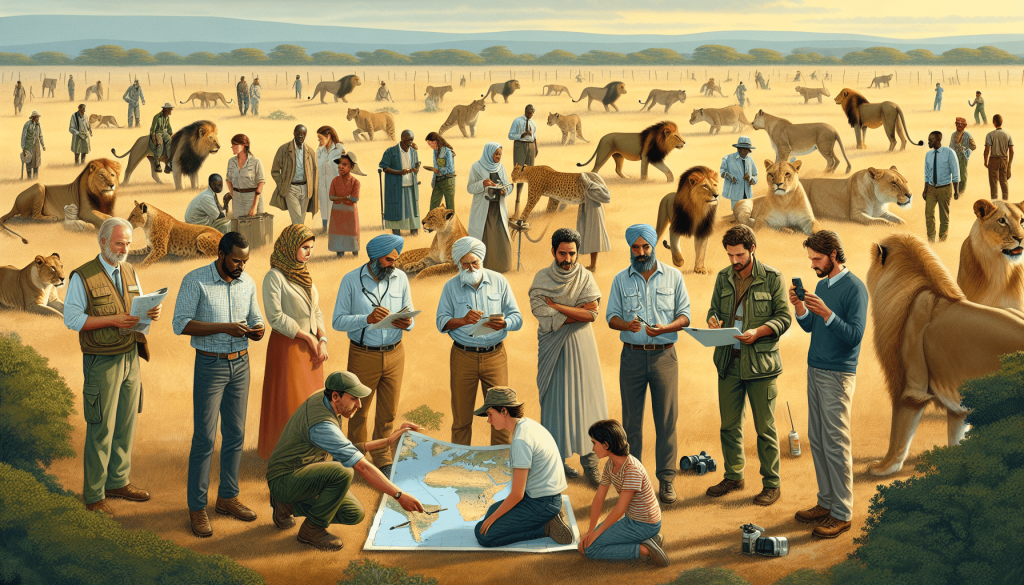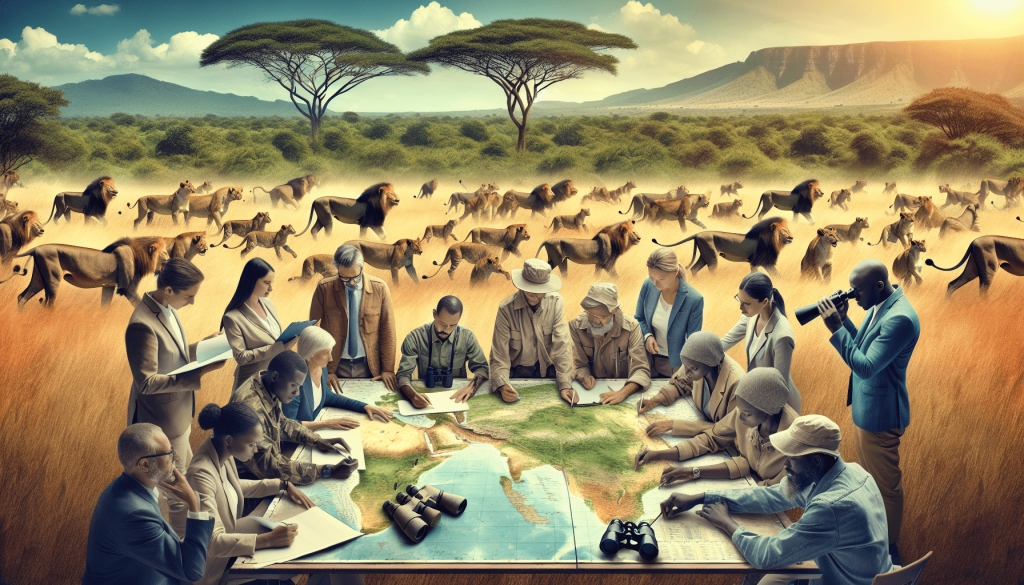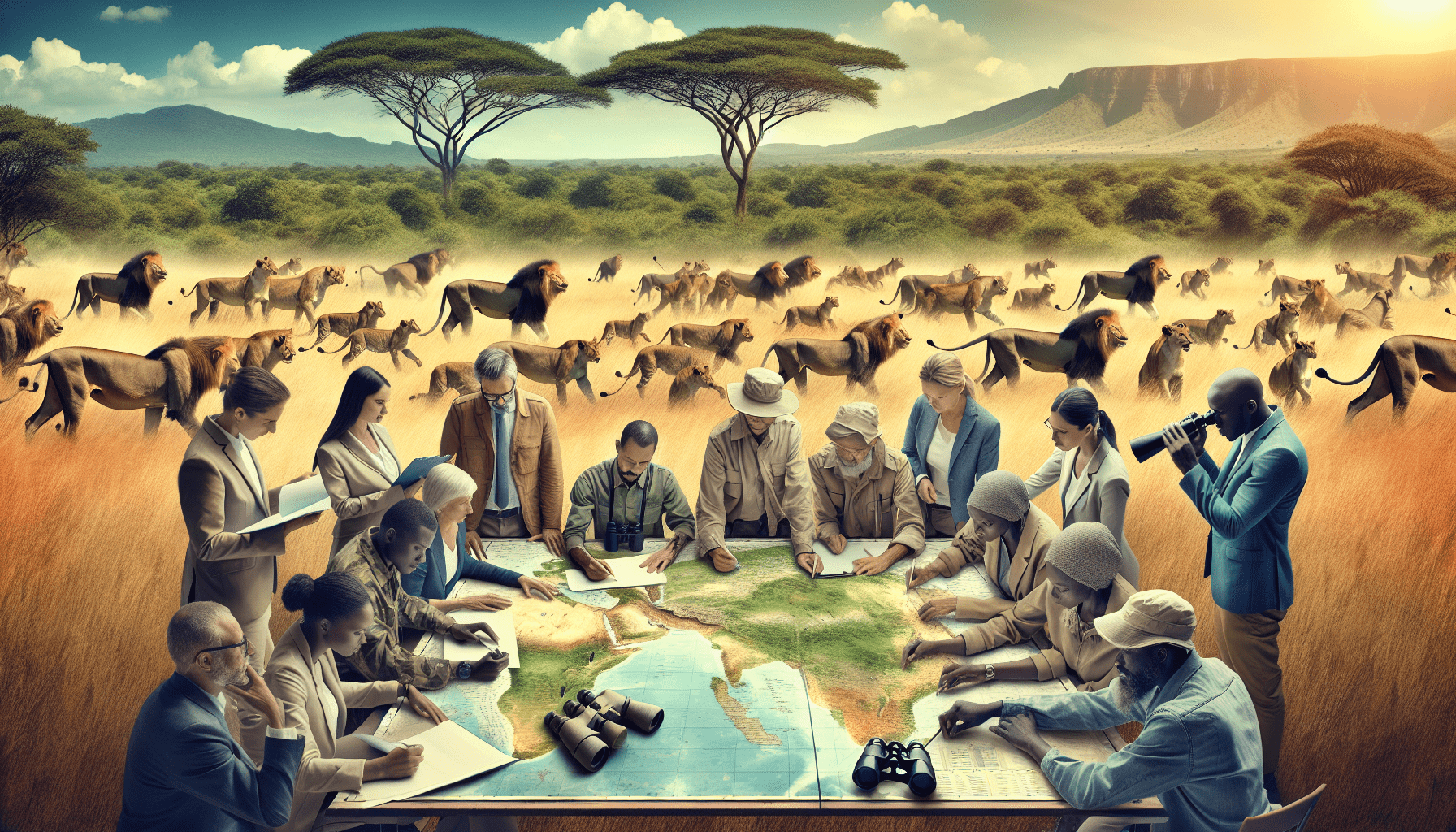In a world where conservation efforts are crucial for the survival of species, communities are rising up to take charge of lion conservation. From Africa to Asia, local communities have become the driving force behind initiatives aimed at preserving and protecting these majestic animals. By working together, these communities are not only helping to ensure the survival of lions, but also fostering a sense of pride and ownership over their natural heritage. Through innovative approaches and collaborative efforts, they are shaping the future of lion conservation and inspiring others to do the same.
Role of Communities in Lion Conservation
Lions, the majestic kings of the African savannah, are an iconic symbol of wildlife and hold a significant place in our natural world. However, the ongoing threats faced by these magnificent creatures have necessitated the active involvement of communities in lion conservation efforts. Community participation is crucial in advocating for the protection of lions, resolving conflicts, and implementing effective conservation initiatives. By working hand in hand with local communities, we can secure a future where lions coexist harmoniously with humans and thrive in their natural habitats.
Involvement in Conservation Efforts
Communities play a vital role in lion conservation by actively participating in various efforts aimed at protecting these charismatic animals. This involvement ranges from supporting anti-poaching patrols to reporting lion sightings and potential threats. By acting as the eyes and ears on the ground, the communities serve as critical partners in the monitoring and surveillance of the lion population. Their engagement and awareness contribute immensely to the success of conservation initiatives.
Advocacy and Awareness
One of the significant contributions of communities to lion conservation is their role in advocacy and raising awareness. Local communities, with their deep understanding of the environment and cultural bonds with wildlife, can be powerful voices in promoting the importance of lion conservation. They can educate their fellow community members, as well as national and international audiences, about the value of lions and the need to protect them. Through storytelling, traditional rituals, and community events, they can instill a sense of pride and responsibility towards lions’ survival.
Conflict Resolution
Human-wildlife conflict presents a significant threat to lion populations, as the encroachment of human settlements into their natural habitats leads to increased instances of livestock depredation and retaliatory killings. Communities are crucial in resolving these conflicts peacefully and finding sustainable solutions. By facilitating dialogue between conservation organizations, local authorities, and community members, conflicts can be addressed through measures such as improved fencing, compensation for cattle losses, and promoting coexistence between humans and lions.
Community-led Conservation Initiatives
In recent years, community-led conservation initiatives have emerged as an effective approach to safeguarding lion populations and their habitats. These initiatives empower local communities to take ownership of their natural resources, benefiting both conservation efforts and the communities themselves.
Community-owned Conservancies
Community-owned conservancies are gaining popularity as a successful model for lion conservation. In these conservancies, local communities hold the authority and responsibility for managing and conserving natural resources within designated areas. This empowerment significantly enhances community involvement and ensures a sustainable approach to lion conservation. By taking pride and ownership of their land, communities become active stewards of the environment, promoting the protection of lion populations and their habitats.
Community-based Wildlife Management
Community-based wildlife management involves the active participation of local communities in the management and monitoring of wildlife populations. The key principle of this approach is to recognize the rights and responsibilities of local communities in their traditional territories. By engaging communities in wildlife monitoring, anti-poaching efforts, and habitat restoration, this approach fosters a sense of guardianship and promotes a long-term commitment to lion conservation.
Community Ecotourism
Community ecotourism initiatives provide economic opportunities for local communities while simultaneously promoting lion conservation. By harnessing the natural and cultural resources in their areas, communities can create sustainable tourism enterprises. These ventures not only generate income but also raise awareness about the importance of protecting lions and their habitats. By directly benefiting from the presence of lions, communities become motivated to conserve these magnificent creatures and their habitats.

Benefits of Community Engagement
Community engagement in lion conservation brings forth a multitude of benefits for both conservation efforts and the communities themselves. This collaborative approach ensures the adoption of sustainable practices, economic empowerment, and the preservation of cultural heritage.
Sustainable Conservation Practices
Involving local communities in lion conservation enables the adoption of sustainable practices that are tailored to the specific ecological and cultural context. Traditional ecological knowledge, passed down through generations, is invaluable in understanding the lion’s behavior, their role in the ecosystem, and effective conservation strategies. By integrating local knowledge with scientific research, conservation efforts become more holistic and effective in ensuring the long-term survival of lions.
Economic Empowerment
Lion conservation can provide substantial economic benefits to local communities, leading to improved livelihoods and increased support for conservation initiatives. Community-owned conservation enterprises, such as eco-lodges and guided wildlife tours, create employment opportunities and generate revenue for communities. This economic empowerment not only reduces reliance on unsustainable practices but also fosters a sense of pride and commitment towards lion conservation.
Preserving Cultural Heritage
Lions hold deep cultural significance in many communities across Africa. Their presence often plays a vital role in cultural rituals, folklore, and traditional practices. Engaging communities in lion conservation efforts ensures the preservation of cultural heritage and traditional beliefs that value the coexistence of humans and wildlife. By recognizing and respecting these cultural bonds, conservation efforts become more inclusive and sustainable, integrating the rich heritage of local communities into the fabric of lion conservation.
Challenges Faced by Communities in Lion Conservation
While communities play a crucial role in lion conservation, they face numerous challenges that hinder their efforts. To effectively address these challenges, it is imperative to understand and mitigate the factors that impede community engagement.
Human-Wildlife Conflict
Human-wildlife conflict remains one of the most significant challenges faced by communities involved in lion conservation. As human populations expand, conflicts arise due to livestock depredation, crop raiding, and the potential threat posed by lions to human safety. These conflicts often lead to retaliatory killings, exacerbating the decline of lion populations. Resolving these conflicts requires innovative solutions that balance the needs of both communities and lions, promoting coexistence and reducing the loss of human and animal lives.
Poaching and Illegal Wildlife Trade
Poaching and the illegal wildlife trade pose severe threats to lion populations, and communities are on the frontlines of combating these criminal activities. Lack of resources, limited law enforcement, and the influence of international criminal networks make it challenging for communities to effectively tackle poaching and the illegal wildlife trade. Strengthening law enforcement efforts, empowering communities with anti-poaching training and equipment, and raising awareness about the detrimental impacts of these activities are essential steps in addressing this critical challenge.
Limited Resources and Infrastructure
Many communities involved in lion conservation face significant resource constraints, including limited access to education, healthcare, and basic infrastructure. These challenges hinder effective community engagement and the implementation of conservation initiatives. Addressing these disparities requires collaborative efforts between governments, non-profit organizations, and local communities to provide essential resources, infrastructure development, and capacity-building programs. By investing in community development, the barriers to effective lion conservation can be overcome.

Successful Examples of Community-led Lion Conservation
Several successful examples of community-led lion conservation initiatives exist across Africa, demonstrating the power of collaboration between communities and conservation organizations. These success stories highlight the tremendous impact that community engagement can have on lion populations and their habitats.
Ol Pejeta Conservancy, Kenya
Ol Pejeta Conservancy in Kenya exemplifies the positive outcomes of community-led lion conservation. By incorporating local communities into various conservation programs, Ol Pejeta has fostered a sense of ownership and responsibility among the communities living adjacent to the conservancy. The conservancy provides employment opportunities, education, and healthcare facilities to nearby communities, creating a mutually beneficial relationship that supports both human development and lion conservation.
Ruaha Carnivore Project, Tanzania
The Ruaha Carnivore Project in Tanzania focuses on mitigating human-wildlife conflict and promoting coexistence between local communities and carnivores, including lions. Through community engagement initiatives such as livestock insurance schemes and the establishment of predator-proof enclosures, the project has successfully reduced retaliatory killings and improved attitudes towards carnivores. By involving communities in conservation efforts, the Ruaha Carnivore Project has ensured the long-term survival of lions in the Ruaha landscape.
Hwange Lion Research Project, Zimbabwe
The Hwange Lion Research Project in Zimbabwe exemplifies the significance of scientific research and community involvement in lion conservation. By studying lion behavior and the ecological interactions within the Hwange National Park, the project has provided valuable insights for conservation strategies. Community engagement activities, such as education programs and livestock management training, have empowered local communities to mitigate human-lion conflicts effectively. This collaboration has resulted in a harmonious coexistence between the local communities and the lions of Hwange.
Collaboration between Communities and Conservation Organizations
The collaboration between communities and conservation organizations is essential in ensuring the success of lion conservation efforts. By working together, these stakeholders can leverage their respective strengths and resources, leading to more comprehensive and impactful conservation initiatives.
Partnerships and Capacity Building
Establishing partnerships between communities and conservation organizations is crucial for building trust, sharing responsibilities, and pooling resources. By working alongside each other, these partnerships enhance the capacity of communities to actively participate in lion conservation. Through skills training, education programs, and the provision of necessary equipment, communities gain the knowledge and tools required to contribute effectively to conservation efforts.
Sharing of Knowledge and Expertise
The sharing of knowledge and expertise is a fundamental aspect of successful collaboration between communities and conservation organizations. Conservation organizations bring scientific research, technical expertise, and organizational support, while communities provide invaluable traditional ecological knowledge and deep understanding of local landscapes. This exchange of knowledge fosters a holistic approach to lion conservation, where local wisdom and scientific insights are combined to develop effective strategies.
Joint Conservation Programs
Joint conservation programs that are developed and implemented collaboratively by communities and conservation organizations are essential for the long-term success of lion conservation. These programs ensure that the priorities and needs of communities are taken into account and that conservation efforts align with the aspirations of the local people. By jointly designing conservation programs, communities and conservation organizations can create a sense of ownership, empowerment, and shared responsibility, leading to more sustainable outcomes.
Lessons Learned from Community-based Lion Conservation
The engagement of local communities in lion conservation has provided valuable lessons that can guide future efforts towards securing the future of these magnificent animals.
Importance of Local Engagement
Local engagement is crucial in lion conservation because it recognizes the unique perspectives and experiences of communities living in close proximity to these animals. By involving local communities from the beginning of conservation initiatives, their knowledge and traditions can be integrated into the decision-making processes. This inclusive approach fosters a sense of ownership and responsibility, leading to more effective and sustainable conservation outcomes.
Tailoring Conservation Strategies
Successful lion conservation requires tailoring conservation strategies to the specific needs and aspirations of local communities. One size does not fit all when it comes to conservation efforts, as each community has its unique challenges and priorities. Understanding the social, cultural, and economic context of communities is essential in designing programs that address their needs while concurrently protecting lion populations. Customized approaches ensure that conservation initiatives are embraced and supported by the local communities.
Monitoring and Evaluation
Monitoring and evaluation are essential aspects of community-based lion conservation to measure the effectiveness of conservation strategies and to make necessary adaptations. Regular monitoring of lion populations, monitoring of human-wildlife conflicts, and gathering community feedback are crucial in understanding the impacts of conservation efforts. By continuously evaluating the outcomes, conservation organizations can identify strengths, challenges, and areas that require improvement, leading to more targeted and successful initiatives.
Scaling up Community-led Conservation Efforts
To ensure the long-term survival of lions, community-led conservation efforts must be scaled up and replicated across lion habitats. This scaling up requires concerted efforts from governments, non-profit organizations, and the international community to provide the necessary policy and legal support, resources, and international cooperation.
Replication of Successful Models
Successful community-led conservation models should be replicated and adapted in other lion habitats across Africa. By identifying and sharing best practices, communities in different regions can learn from one another and implement strategies that have proven effective. The replication of successful models allows for the transfer of knowledge, empowering local communities to take ownership of their natural resources and lead successful conservation efforts.
Policy and Legal Support
Governments play a critical role in supporting community-led lion conservation through the development and enforcement of policies and legislation. These policy frameworks should recognize the rights and responsibilities of local communities, provide legal protection for lions and their habitats, and ensure equitable resource-sharing mechanisms. By establishing a supportive legal framework, governments can encourage community engagement and create an enabling environment for successful conservation initiatives.
International Cooperation
International cooperation is indispensable in scaling up community-led lion conservation efforts. This cooperation involves collaboration between governments, non-profit organizations, and international stakeholders to share resources, knowledge, and expertise. By working together, these stakeholders can address transboundary issues, promote sustainable funding mechanisms, and implement joint conservation programs. The collective efforts of the international community are essential in securing a future where lions thrive and coexist with humans.
The Future of Lion Conservation: A Community-driven Approach
The future of lion conservation lies in a community-driven approach, where local communities take ownership and actively participate in efforts to protect these majestic creatures. Empowering local communities, promoting coexistence between humans and lions, and sustaining conservation success are the key pillars of this approach.
Empowering Local Communities
Empowering local communities is fundamental to the success of lion conservation. By providing them with the necessary resources, capacity-building programs, and economic opportunities, communities can become active partners in lion conservation. This empowerment fosters a deep sense of pride, responsibility, and commitment to protecting lions and their habitats, resulting in more effective and sustainable conservation outcomes.
Promoting Coexistence between Humans and Lions
Promoting coexistence between humans and lions is essential in reducing conflicts and ensuring the long-term survival of both communities and these magnificent animals. By implementing innovative solutions such as improved livestock management practices, community-based early warning systems, and predator-proof enclosures, communities can minimize human-wildlife conflict while safeguarding their livelihoods. Education programs that raise awareness about the value of lions and the benefits of coexistence are also instrumental in fostering a culture of tolerance and respect.
Sustaining Conservation Success
Sustaining conservation success requires long-term commitment and continuous engagement with local communities. Conservation organizations, governments, and other stakeholders must prioritize the development of sustainable funding mechanisms that ensure the continuity of community-led conservation efforts. Ongoing monitoring, evaluation, and adaptive management are crucial in identifying emerging challenges, measuring the impact of conservation strategies, and making necessary adjustments. By investing in the sustainability of community-led initiatives, we can secure the future of lions and preserve these iconic symbols of our natural world.
In conclusion, the power of unity between communities and conservation organizations is shaping the future of lion conservation. The involvement of communities in conservation efforts, community-led initiatives, and collaboration between stakeholders demonstrate the importance of community engagement. By recognizing the role of local communities, tailoring conservation strategies, and promoting coexistence, we can forge a path towards a future where lions thrive, and their cultural and ecological significance is preserved for generations to come. Together, we can harness the strength of unity and secure a bright future for these majestic kings of the African savannah.

